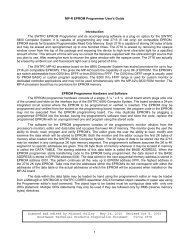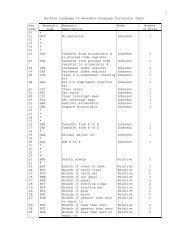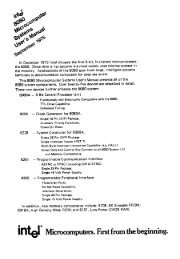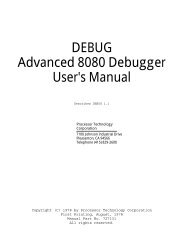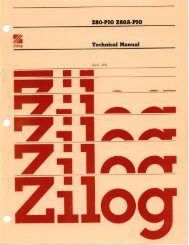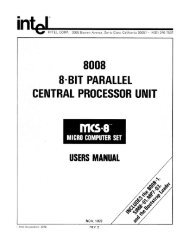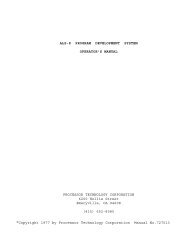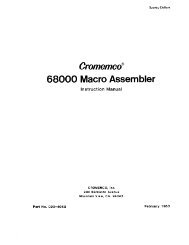The System Manual of SOL-20 - History of Computers
The System Manual of SOL-20 - History of Computers
The System Manual of SOL-20 - History of Computers
You also want an ePaper? Increase the reach of your titles
YUMPU automatically turns print PDFs into web optimized ePapers that Google loves.
PROCESSOR TECHNOLOGY CORPORATION<br />
Sol THEORY OF OPERATION<br />
SECTION VIII<br />
respectively, prevent damage to the logic circuitry in the Input/<br />
Output section due to inductive kickback. R155 and 156 are current<br />
limiters that keep the relay contacts from "welding" together.<br />
When the CDI is in the write mode, data is input to the UART<br />
(U69) under control <strong>of</strong> !PORT_OUT_FB. Upon completion <strong>of</strong> this strobe,<br />
the transmit sequence is initiated within the UART, with the transmission<br />
rate being governed by BYTE_WRITE_CLOCK.<br />
<strong>The</strong> transmission sequence begins with a start bit, a low<br />
(data zero) on the UART's TO output. It is followed by eight data<br />
bits and two stop bits (high on the UART's TO output), with the number<br />
<strong>of</strong> bits being fixed by the connections to pins 34 through 39 <strong>of</strong><br />
U69.<br />
<strong>The</strong> data from U69 is applied to the D input <strong>of</strong> D flip-flop<br />
U100 which is clocked at 1<strong>20</strong>0 Hz. Consequently, the output on pin 1<br />
<strong>of</strong> U100 follows the input data on pin 5 after the rising edge <strong>of</strong> the<br />
1<strong>20</strong>0 Hz clock. This output is connected to the reset (pin 4) <strong>of</strong><br />
U101, so when the data out <strong>of</strong> the UART is high, the first section in<br />
U101 is forced to a reset condition. In this condition the J and K<br />
inputs to the second stage <strong>of</strong> U101 are held high which allows the<br />
flip-flop to change state on the rising edge <strong>of</strong> the clock.<br />
<strong>The</strong> clock for U101 (OUTPUT_CLOCK) is 2400 Hz in the high<br />
speed mode or 4800 Hz in the low speed mode. This clock is derived<br />
from 2400 Hz in conjunction with the low speed select signal in NAND<br />
gate U98 and exclusive-OR gate U99.<br />
In the high speed mode, pins 12 and 13 <strong>of</strong> U98 are held low,<br />
thus holding pin 10 <strong>of</strong> U98 high. As a result the 2400 Hz signal is<br />
inverted in U99 to become the clock for U101.<br />
Pins 12 and 13 <strong>of</strong> U98 are held high, however, in the low<br />
speed mode to enable U98. In this case R117 and C47 provide a delay<br />
in the U98 gate. When the 2400 Hz signal on pin 2 <strong>of</strong> U99 changes<br />
state, so does pin 3 <strong>of</strong> U99. Also, C47 charges through R117 for<br />
several usec, at which point pin 10 <strong>of</strong> U98 is brought to the opposite<br />
polarity. <strong>The</strong> output from U99 then goes high. A series <strong>of</strong> positive<br />
pulses, with a pulse width approximately equal to the R117, C47 time<br />
constant (10 usec) and occuring at every transition <strong>of</strong> the 2400 Hz<br />
signal, appears on pin 3 <strong>of</strong> U99. This circuit thus operates as a<br />
frequency doubler in the low speed mode to provide a 4800 Hz clock<br />
for U101.<br />
<strong>The</strong> 2400 Hz signal from which the U101 clocks are derived also<br />
produces the 1<strong>20</strong>0 Hz clock signal for U100. As a result the 1<strong>20</strong>0<br />
Hz signal changes state following a propagation delay after the 2400<br />
Hz signal falls.<br />
VIII-35



